Work Performance, Human Factors, and Healthcare Safety: A Report
VerifiedAdded on 2022/09/29
|10
|2944
|20
Report
AI Summary
This report delves into the critical role of human factors in influencing work performance, quality of care, and patient safety within healthcare institutions. It explores various ergonomic elements, including workload, working shifts, workplace environment, communication, organizational culture, leadership, and employee skills and competency. The report examines how these factors impact employee productivity, job satisfaction, and adherence to policies. It further discusses the effects of communication errors, workplace culture, and leadership styles on patient outcomes. The importance of employee health, work-life balance, and the use of technology are also considered. The report concludes by emphasizing that addressing these human factors is essential for fostering a safe and effective healthcare environment, ultimately enhancing patient safety and satisfaction. The report highlights the intricate relationship between human behavior, organizational structures, and the delivery of quality healthcare services.
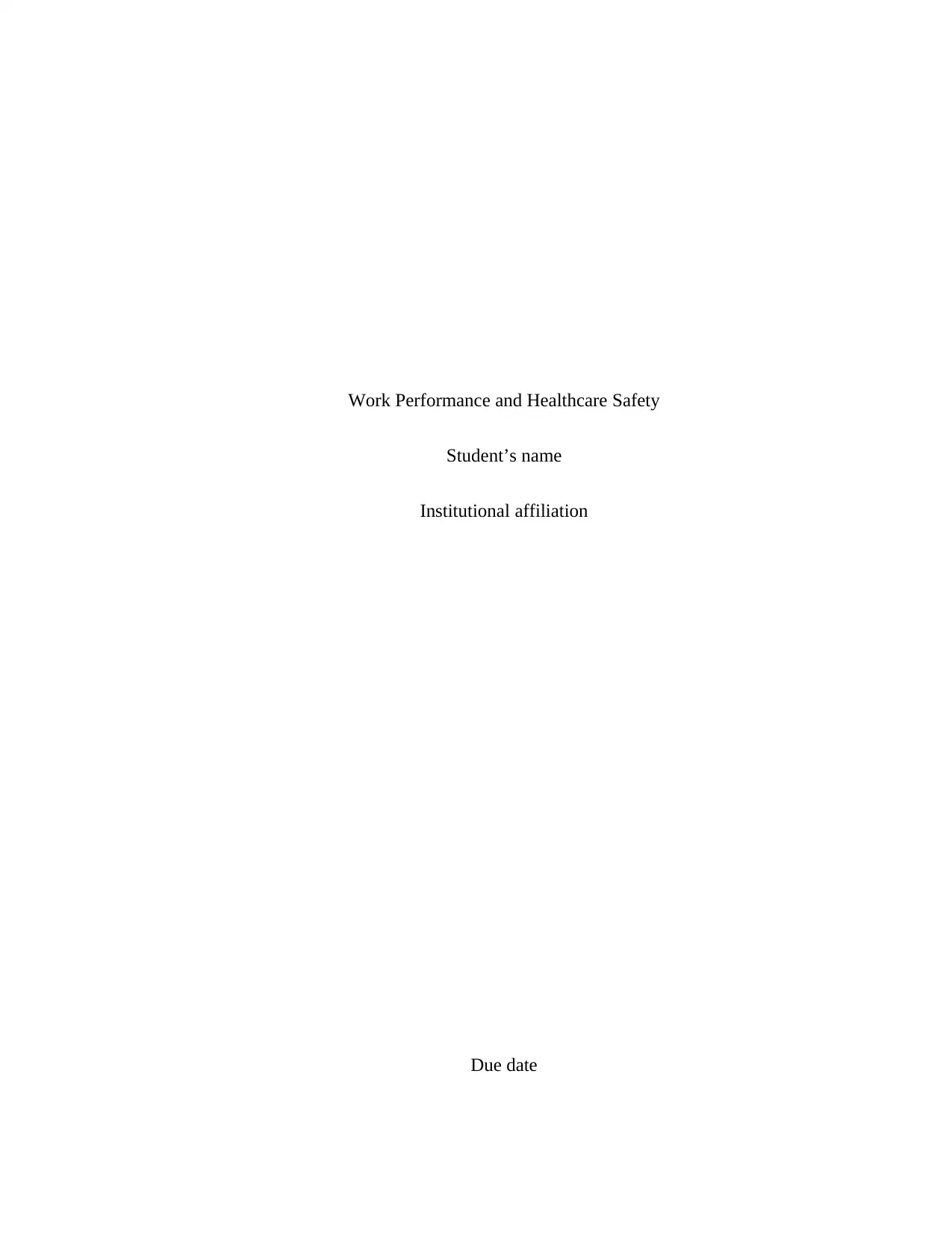
Work Performance and Healthcare Safety
Student’s name
Institutional affiliation
Due date
Student’s name
Institutional affiliation
Due date
Paraphrase This Document
Need a fresh take? Get an instant paraphrase of this document with our AI Paraphraser
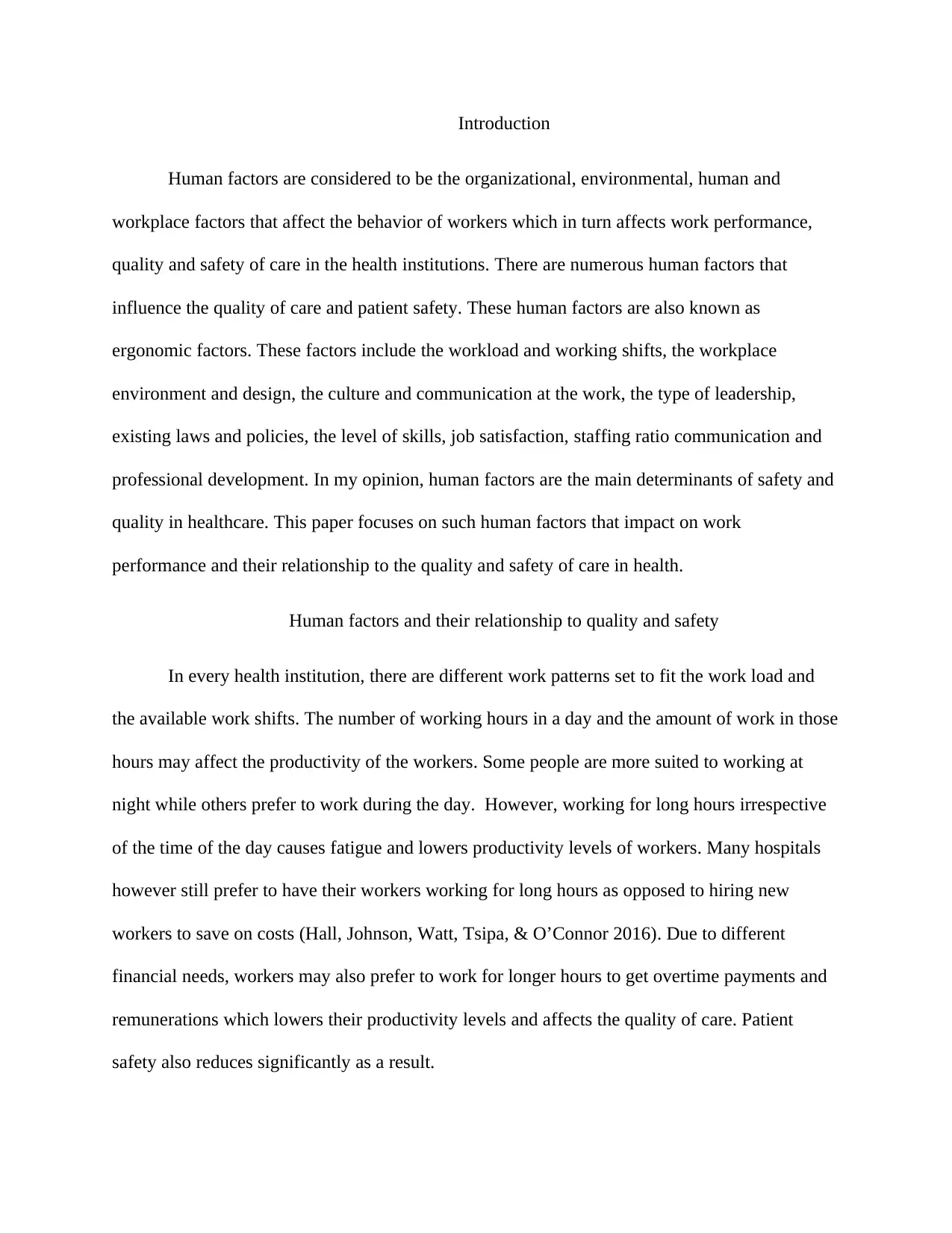
Introduction
Human factors are considered to be the organizational, environmental, human and
workplace factors that affect the behavior of workers which in turn affects work performance,
quality and safety of care in the health institutions. There are numerous human factors that
influence the quality of care and patient safety. These human factors are also known as
ergonomic factors. These factors include the workload and working shifts, the workplace
environment and design, the culture and communication at the work, the type of leadership,
existing laws and policies, the level of skills, job satisfaction, staffing ratio communication and
professional development. In my opinion, human factors are the main determinants of safety and
quality in healthcare. This paper focuses on such human factors that impact on work
performance and their relationship to the quality and safety of care in health.
Human factors and their relationship to quality and safety
In every health institution, there are different work patterns set to fit the work load and
the available work shifts. The number of working hours in a day and the amount of work in those
hours may affect the productivity of the workers. Some people are more suited to working at
night while others prefer to work during the day. However, working for long hours irrespective
of the time of the day causes fatigue and lowers productivity levels of workers. Many hospitals
however still prefer to have their workers working for long hours as opposed to hiring new
workers to save on costs (Hall, Johnson, Watt, Tsipa, & O’Connor 2016). Due to different
financial needs, workers may also prefer to work for longer hours to get overtime payments and
remunerations which lowers their productivity levels and affects the quality of care. Patient
safety also reduces significantly as a result.
Human factors are considered to be the organizational, environmental, human and
workplace factors that affect the behavior of workers which in turn affects work performance,
quality and safety of care in the health institutions. There are numerous human factors that
influence the quality of care and patient safety. These human factors are also known as
ergonomic factors. These factors include the workload and working shifts, the workplace
environment and design, the culture and communication at the work, the type of leadership,
existing laws and policies, the level of skills, job satisfaction, staffing ratio communication and
professional development. In my opinion, human factors are the main determinants of safety and
quality in healthcare. This paper focuses on such human factors that impact on work
performance and their relationship to the quality and safety of care in health.
Human factors and their relationship to quality and safety
In every health institution, there are different work patterns set to fit the work load and
the available work shifts. The number of working hours in a day and the amount of work in those
hours may affect the productivity of the workers. Some people are more suited to working at
night while others prefer to work during the day. However, working for long hours irrespective
of the time of the day causes fatigue and lowers productivity levels of workers. Many hospitals
however still prefer to have their workers working for long hours as opposed to hiring new
workers to save on costs (Hall, Johnson, Watt, Tsipa, & O’Connor 2016). Due to different
financial needs, workers may also prefer to work for longer hours to get overtime payments and
remunerations which lowers their productivity levels and affects the quality of care. Patient
safety also reduces significantly as a result.
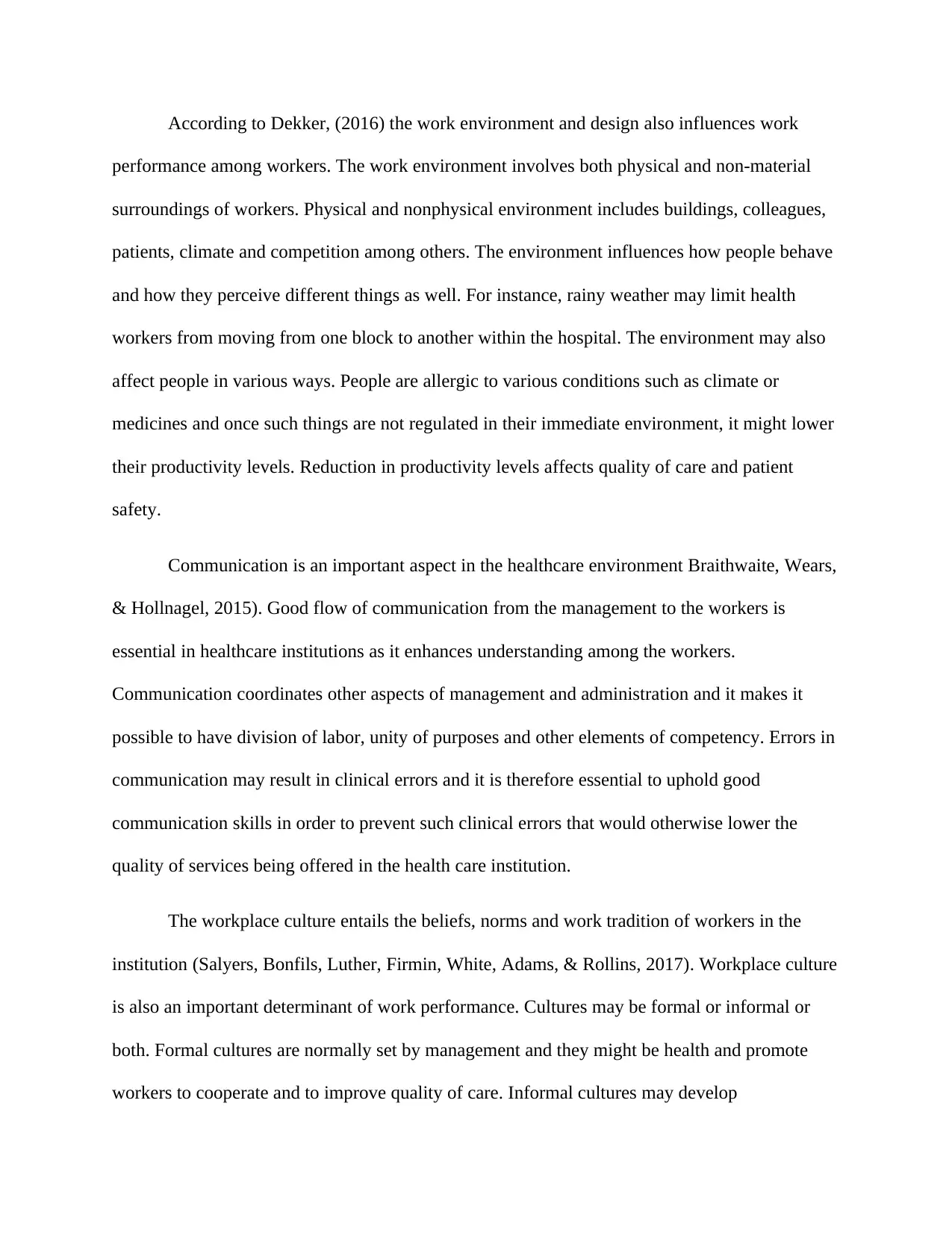
According to Dekker, (2016) the work environment and design also influences work
performance among workers. The work environment involves both physical and non-material
surroundings of workers. Physical and nonphysical environment includes buildings, colleagues,
patients, climate and competition among others. The environment influences how people behave
and how they perceive different things as well. For instance, rainy weather may limit health
workers from moving from one block to another within the hospital. The environment may also
affect people in various ways. People are allergic to various conditions such as climate or
medicines and once such things are not regulated in their immediate environment, it might lower
their productivity levels. Reduction in productivity levels affects quality of care and patient
safety.
Communication is an important aspect in the healthcare environment Braithwaite, Wears,
& Hollnagel, 2015). Good flow of communication from the management to the workers is
essential in healthcare institutions as it enhances understanding among the workers.
Communication coordinates other aspects of management and administration and it makes it
possible to have division of labor, unity of purposes and other elements of competency. Errors in
communication may result in clinical errors and it is therefore essential to uphold good
communication skills in order to prevent such clinical errors that would otherwise lower the
quality of services being offered in the health care institution.
The workplace culture entails the beliefs, norms and work tradition of workers in the
institution (Salyers, Bonfils, Luther, Firmin, White, Adams, & Rollins, 2017). Workplace culture
is also an important determinant of work performance. Cultures may be formal or informal or
both. Formal cultures are normally set by management and they might be health and promote
workers to cooperate and to improve quality of care. Informal cultures may develop
performance among workers. The work environment involves both physical and non-material
surroundings of workers. Physical and nonphysical environment includes buildings, colleagues,
patients, climate and competition among others. The environment influences how people behave
and how they perceive different things as well. For instance, rainy weather may limit health
workers from moving from one block to another within the hospital. The environment may also
affect people in various ways. People are allergic to various conditions such as climate or
medicines and once such things are not regulated in their immediate environment, it might lower
their productivity levels. Reduction in productivity levels affects quality of care and patient
safety.
Communication is an important aspect in the healthcare environment Braithwaite, Wears,
& Hollnagel, 2015). Good flow of communication from the management to the workers is
essential in healthcare institutions as it enhances understanding among the workers.
Communication coordinates other aspects of management and administration and it makes it
possible to have division of labor, unity of purposes and other elements of competency. Errors in
communication may result in clinical errors and it is therefore essential to uphold good
communication skills in order to prevent such clinical errors that would otherwise lower the
quality of services being offered in the health care institution.
The workplace culture entails the beliefs, norms and work tradition of workers in the
institution (Salyers, Bonfils, Luther, Firmin, White, Adams, & Rollins, 2017). Workplace culture
is also an important determinant of work performance. Cultures may be formal or informal or
both. Formal cultures are normally set by management and they might be health and promote
workers to cooperate and to improve quality of care. Informal cultures may develop
⊘ This is a preview!⊘
Do you want full access?
Subscribe today to unlock all pages.

Trusted by 1+ million students worldwide
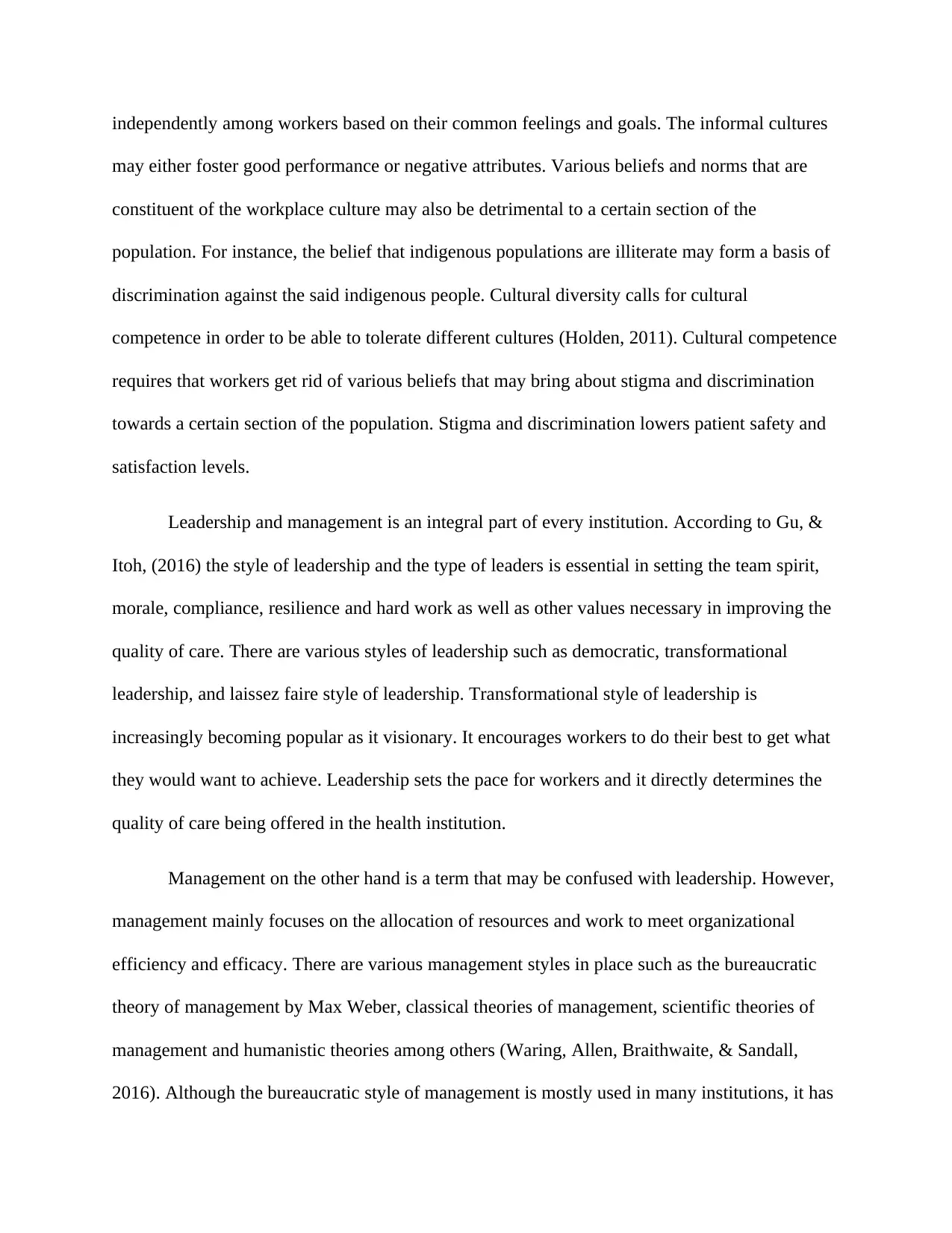
independently among workers based on their common feelings and goals. The informal cultures
may either foster good performance or negative attributes. Various beliefs and norms that are
constituent of the workplace culture may also be detrimental to a certain section of the
population. For instance, the belief that indigenous populations are illiterate may form a basis of
discrimination against the said indigenous people. Cultural diversity calls for cultural
competence in order to be able to tolerate different cultures (Holden, 2011). Cultural competence
requires that workers get rid of various beliefs that may bring about stigma and discrimination
towards a certain section of the population. Stigma and discrimination lowers patient safety and
satisfaction levels.
Leadership and management is an integral part of every institution. According to Gu, &
Itoh, (2016) the style of leadership and the type of leaders is essential in setting the team spirit,
morale, compliance, resilience and hard work as well as other values necessary in improving the
quality of care. There are various styles of leadership such as democratic, transformational
leadership, and laissez faire style of leadership. Transformational style of leadership is
increasingly becoming popular as it visionary. It encourages workers to do their best to get what
they would want to achieve. Leadership sets the pace for workers and it directly determines the
quality of care being offered in the health institution.
Management on the other hand is a term that may be confused with leadership. However,
management mainly focuses on the allocation of resources and work to meet organizational
efficiency and efficacy. There are various management styles in place such as the bureaucratic
theory of management by Max Weber, classical theories of management, scientific theories of
management and humanistic theories among others (Waring, Allen, Braithwaite, & Sandall,
2016). Although the bureaucratic style of management is mostly used in many institutions, it has
may either foster good performance or negative attributes. Various beliefs and norms that are
constituent of the workplace culture may also be detrimental to a certain section of the
population. For instance, the belief that indigenous populations are illiterate may form a basis of
discrimination against the said indigenous people. Cultural diversity calls for cultural
competence in order to be able to tolerate different cultures (Holden, 2011). Cultural competence
requires that workers get rid of various beliefs that may bring about stigma and discrimination
towards a certain section of the population. Stigma and discrimination lowers patient safety and
satisfaction levels.
Leadership and management is an integral part of every institution. According to Gu, &
Itoh, (2016) the style of leadership and the type of leaders is essential in setting the team spirit,
morale, compliance, resilience and hard work as well as other values necessary in improving the
quality of care. There are various styles of leadership such as democratic, transformational
leadership, and laissez faire style of leadership. Transformational style of leadership is
increasingly becoming popular as it visionary. It encourages workers to do their best to get what
they would want to achieve. Leadership sets the pace for workers and it directly determines the
quality of care being offered in the health institution.
Management on the other hand is a term that may be confused with leadership. However,
management mainly focuses on the allocation of resources and work to meet organizational
efficiency and efficacy. There are various management styles in place such as the bureaucratic
theory of management by Max Weber, classical theories of management, scientific theories of
management and humanistic theories among others (Waring, Allen, Braithwaite, & Sandall,
2016). Although the bureaucratic style of management is mostly used in many institutions, it has
Paraphrase This Document
Need a fresh take? Get an instant paraphrase of this document with our AI Paraphraser
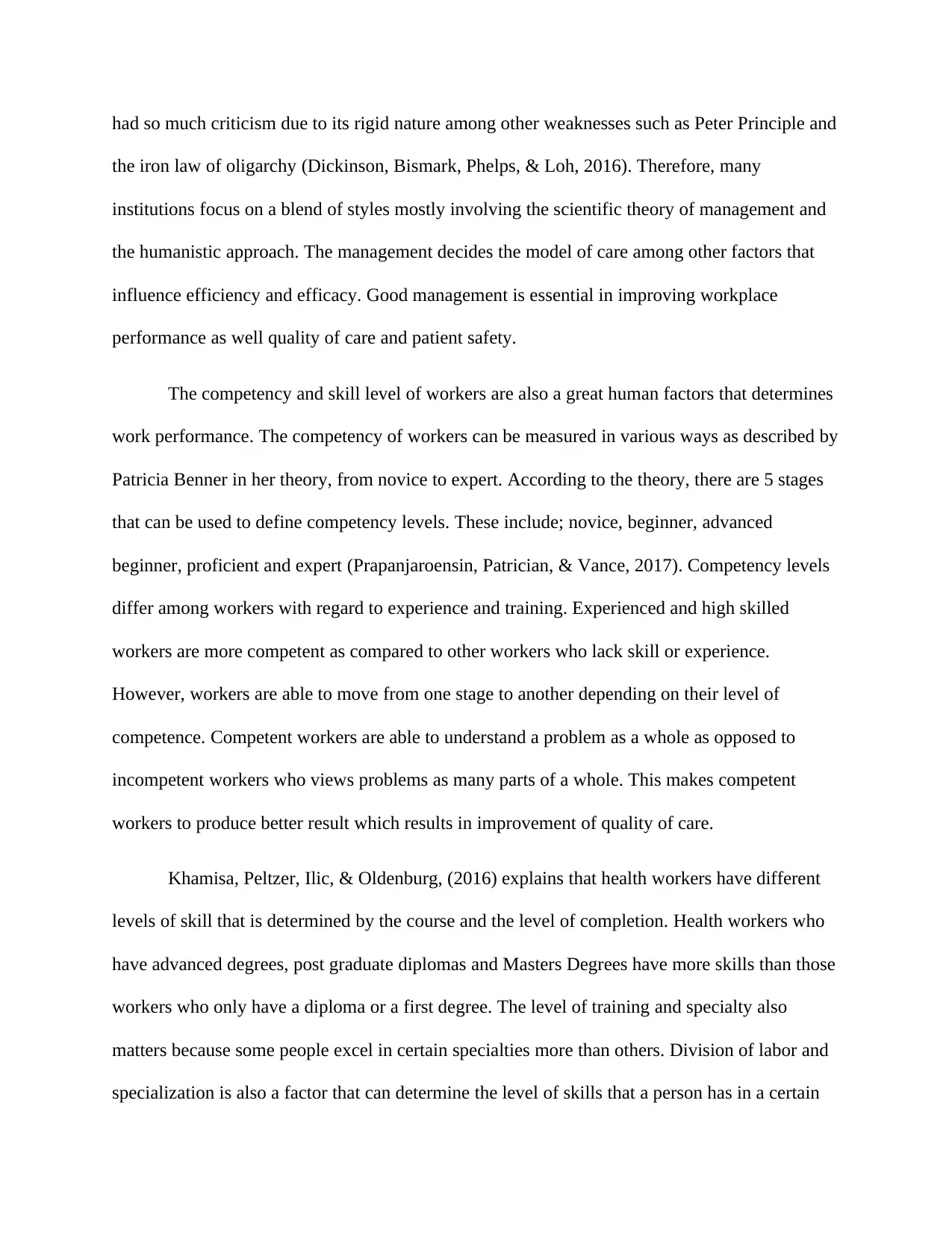
had so much criticism due to its rigid nature among other weaknesses such as Peter Principle and
the iron law of oligarchy (Dickinson, Bismark, Phelps, & Loh, 2016). Therefore, many
institutions focus on a blend of styles mostly involving the scientific theory of management and
the humanistic approach. The management decides the model of care among other factors that
influence efficiency and efficacy. Good management is essential in improving workplace
performance as well quality of care and patient safety.
The competency and skill level of workers are also a great human factors that determines
work performance. The competency of workers can be measured in various ways as described by
Patricia Benner in her theory, from novice to expert. According to the theory, there are 5 stages
that can be used to define competency levels. These include; novice, beginner, advanced
beginner, proficient and expert (Prapanjaroensin, Patrician, & Vance, 2017). Competency levels
differ among workers with regard to experience and training. Experienced and high skilled
workers are more competent as compared to other workers who lack skill or experience.
However, workers are able to move from one stage to another depending on their level of
competence. Competent workers are able to understand a problem as a whole as opposed to
incompetent workers who views problems as many parts of a whole. This makes competent
workers to produce better result which results in improvement of quality of care.
Khamisa, Peltzer, Ilic, & Oldenburg, (2016) explains that health workers have different
levels of skill that is determined by the course and the level of completion. Health workers who
have advanced degrees, post graduate diplomas and Masters Degrees have more skills than those
workers who only have a diploma or a first degree. The level of training and specialty also
matters because some people excel in certain specialties more than others. Division of labor and
specialization is also a factor that can determine the level of skills that a person has in a certain
the iron law of oligarchy (Dickinson, Bismark, Phelps, & Loh, 2016). Therefore, many
institutions focus on a blend of styles mostly involving the scientific theory of management and
the humanistic approach. The management decides the model of care among other factors that
influence efficiency and efficacy. Good management is essential in improving workplace
performance as well quality of care and patient safety.
The competency and skill level of workers are also a great human factors that determines
work performance. The competency of workers can be measured in various ways as described by
Patricia Benner in her theory, from novice to expert. According to the theory, there are 5 stages
that can be used to define competency levels. These include; novice, beginner, advanced
beginner, proficient and expert (Prapanjaroensin, Patrician, & Vance, 2017). Competency levels
differ among workers with regard to experience and training. Experienced and high skilled
workers are more competent as compared to other workers who lack skill or experience.
However, workers are able to move from one stage to another depending on their level of
competence. Competent workers are able to understand a problem as a whole as opposed to
incompetent workers who views problems as many parts of a whole. This makes competent
workers to produce better result which results in improvement of quality of care.
Khamisa, Peltzer, Ilic, & Oldenburg, (2016) explains that health workers have different
levels of skill that is determined by the course and the level of completion. Health workers who
have advanced degrees, post graduate diplomas and Masters Degrees have more skills than those
workers who only have a diploma or a first degree. The level of training and specialty also
matters because some people excel in certain specialties more than others. Division of labor and
specialization is also a factor that can determine the level of skills that a person has in a certain
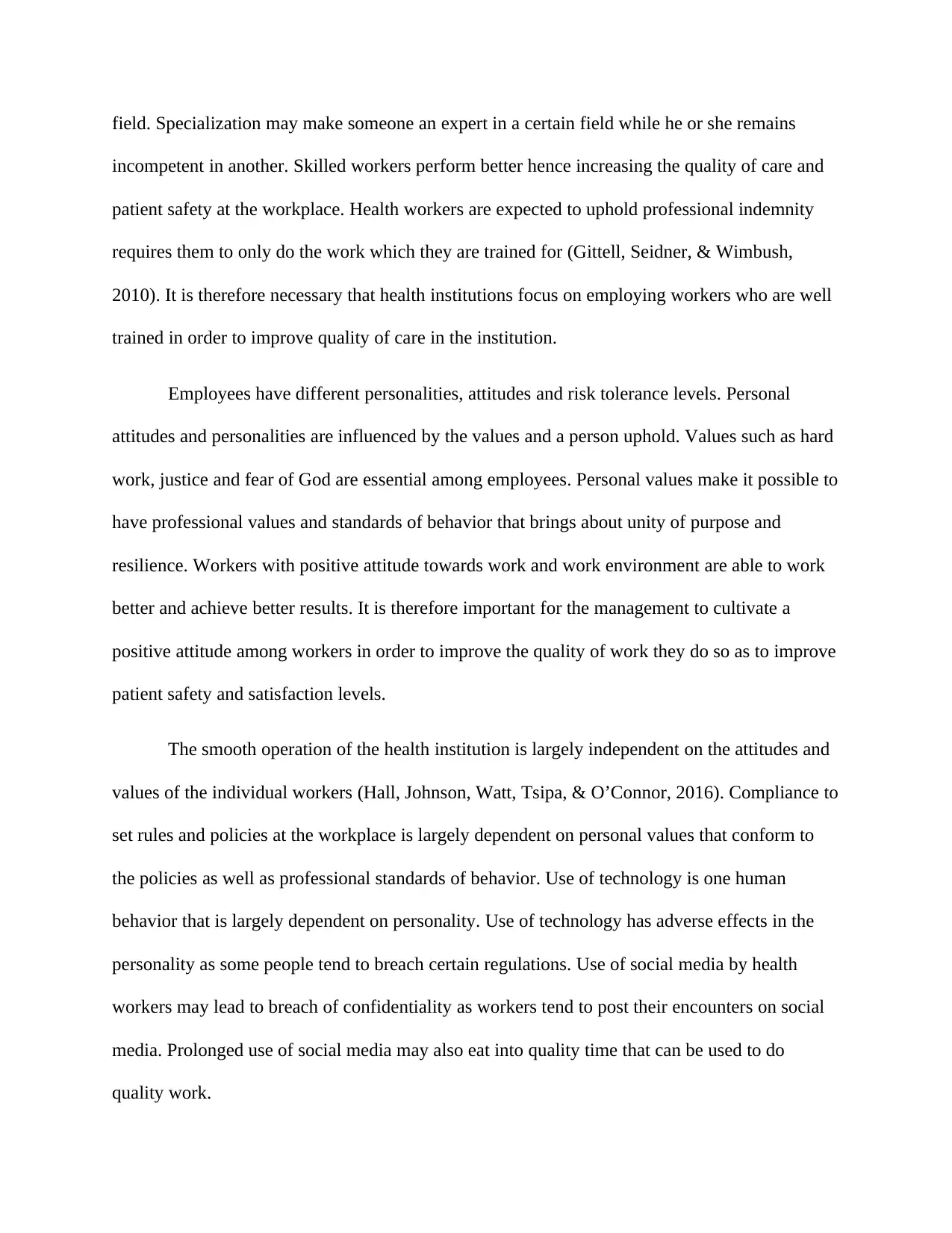
field. Specialization may make someone an expert in a certain field while he or she remains
incompetent in another. Skilled workers perform better hence increasing the quality of care and
patient safety at the workplace. Health workers are expected to uphold professional indemnity
requires them to only do the work which they are trained for (Gittell, Seidner, & Wimbush,
2010). It is therefore necessary that health institutions focus on employing workers who are well
trained in order to improve quality of care in the institution.
Employees have different personalities, attitudes and risk tolerance levels. Personal
attitudes and personalities are influenced by the values and a person uphold. Values such as hard
work, justice and fear of God are essential among employees. Personal values make it possible to
have professional values and standards of behavior that brings about unity of purpose and
resilience. Workers with positive attitude towards work and work environment are able to work
better and achieve better results. It is therefore important for the management to cultivate a
positive attitude among workers in order to improve the quality of work they do so as to improve
patient safety and satisfaction levels.
The smooth operation of the health institution is largely independent on the attitudes and
values of the individual workers (Hall, Johnson, Watt, Tsipa, & O’Connor, 2016). Compliance to
set rules and policies at the workplace is largely dependent on personal values that conform to
the policies as well as professional standards of behavior. Use of technology is one human
behavior that is largely dependent on personality. Use of technology has adverse effects in the
personality as some people tend to breach certain regulations. Use of social media by health
workers may lead to breach of confidentiality as workers tend to post their encounters on social
media. Prolonged use of social media may also eat into quality time that can be used to do
quality work.
incompetent in another. Skilled workers perform better hence increasing the quality of care and
patient safety at the workplace. Health workers are expected to uphold professional indemnity
requires them to only do the work which they are trained for (Gittell, Seidner, & Wimbush,
2010). It is therefore necessary that health institutions focus on employing workers who are well
trained in order to improve quality of care in the institution.
Employees have different personalities, attitudes and risk tolerance levels. Personal
attitudes and personalities are influenced by the values and a person uphold. Values such as hard
work, justice and fear of God are essential among employees. Personal values make it possible to
have professional values and standards of behavior that brings about unity of purpose and
resilience. Workers with positive attitude towards work and work environment are able to work
better and achieve better results. It is therefore important for the management to cultivate a
positive attitude among workers in order to improve the quality of work they do so as to improve
patient safety and satisfaction levels.
The smooth operation of the health institution is largely independent on the attitudes and
values of the individual workers (Hall, Johnson, Watt, Tsipa, & O’Connor, 2016). Compliance to
set rules and policies at the workplace is largely dependent on personal values that conform to
the policies as well as professional standards of behavior. Use of technology is one human
behavior that is largely dependent on personality. Use of technology has adverse effects in the
personality as some people tend to breach certain regulations. Use of social media by health
workers may lead to breach of confidentiality as workers tend to post their encounters on social
media. Prolonged use of social media may also eat into quality time that can be used to do
quality work.
⊘ This is a preview!⊘
Do you want full access?
Subscribe today to unlock all pages.

Trusted by 1+ million students worldwide
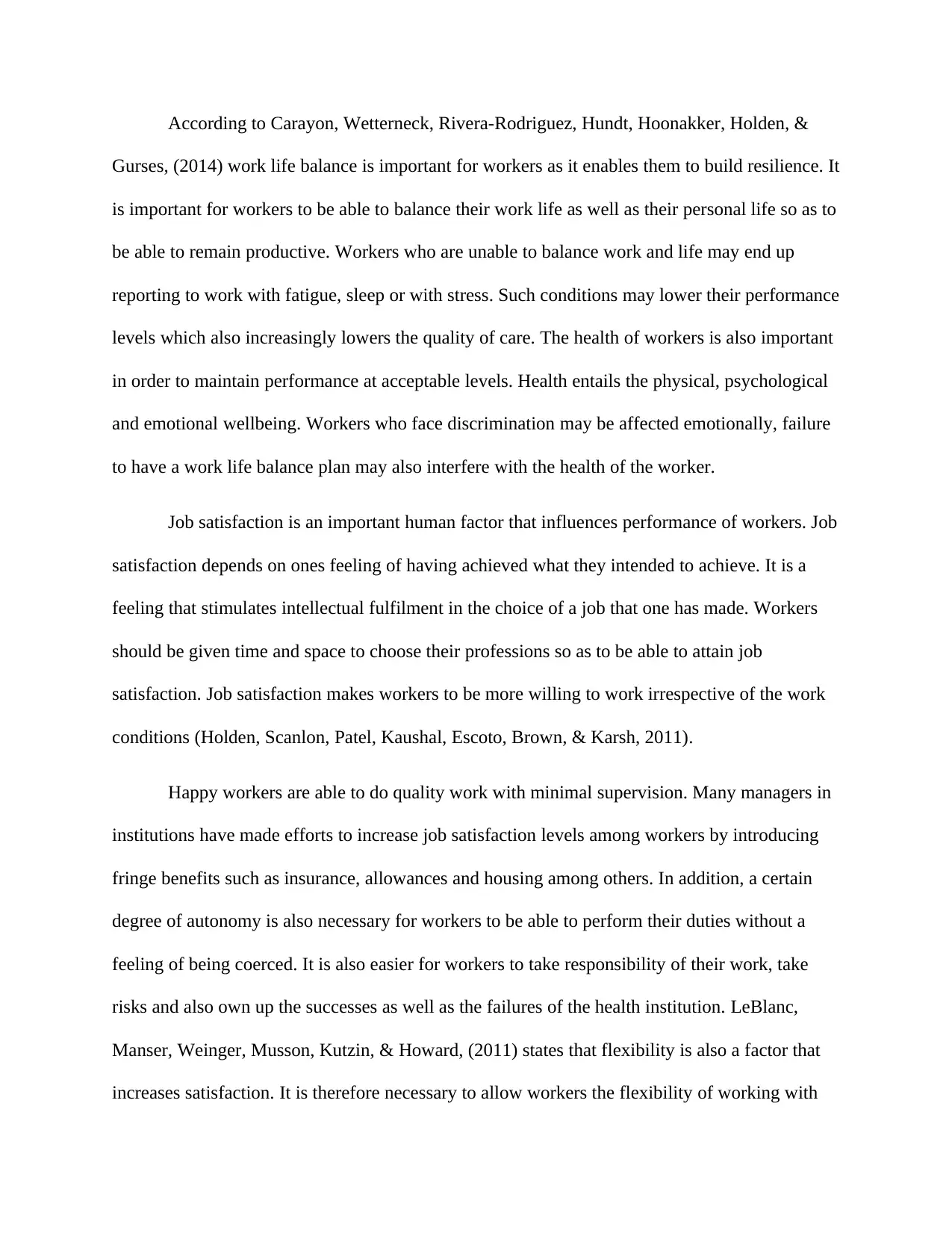
According to Carayon, Wetterneck, Rivera-Rodriguez, Hundt, Hoonakker, Holden, &
Gurses, (2014) work life balance is important for workers as it enables them to build resilience. It
is important for workers to be able to balance their work life as well as their personal life so as to
be able to remain productive. Workers who are unable to balance work and life may end up
reporting to work with fatigue, sleep or with stress. Such conditions may lower their performance
levels which also increasingly lowers the quality of care. The health of workers is also important
in order to maintain performance at acceptable levels. Health entails the physical, psychological
and emotional wellbeing. Workers who face discrimination may be affected emotionally, failure
to have a work life balance plan may also interfere with the health of the worker.
Job satisfaction is an important human factor that influences performance of workers. Job
satisfaction depends on ones feeling of having achieved what they intended to achieve. It is a
feeling that stimulates intellectual fulfilment in the choice of a job that one has made. Workers
should be given time and space to choose their professions so as to be able to attain job
satisfaction. Job satisfaction makes workers to be more willing to work irrespective of the work
conditions (Holden, Scanlon, Patel, Kaushal, Escoto, Brown, & Karsh, 2011).
Happy workers are able to do quality work with minimal supervision. Many managers in
institutions have made efforts to increase job satisfaction levels among workers by introducing
fringe benefits such as insurance, allowances and housing among others. In addition, a certain
degree of autonomy is also necessary for workers to be able to perform their duties without a
feeling of being coerced. It is also easier for workers to take responsibility of their work, take
risks and also own up the successes as well as the failures of the health institution. LeBlanc,
Manser, Weinger, Musson, Kutzin, & Howard, (2011) states that flexibility is also a factor that
increases satisfaction. It is therefore necessary to allow workers the flexibility of working with
Gurses, (2014) work life balance is important for workers as it enables them to build resilience. It
is important for workers to be able to balance their work life as well as their personal life so as to
be able to remain productive. Workers who are unable to balance work and life may end up
reporting to work with fatigue, sleep or with stress. Such conditions may lower their performance
levels which also increasingly lowers the quality of care. The health of workers is also important
in order to maintain performance at acceptable levels. Health entails the physical, psychological
and emotional wellbeing. Workers who face discrimination may be affected emotionally, failure
to have a work life balance plan may also interfere with the health of the worker.
Job satisfaction is an important human factor that influences performance of workers. Job
satisfaction depends on ones feeling of having achieved what they intended to achieve. It is a
feeling that stimulates intellectual fulfilment in the choice of a job that one has made. Workers
should be given time and space to choose their professions so as to be able to attain job
satisfaction. Job satisfaction makes workers to be more willing to work irrespective of the work
conditions (Holden, Scanlon, Patel, Kaushal, Escoto, Brown, & Karsh, 2011).
Happy workers are able to do quality work with minimal supervision. Many managers in
institutions have made efforts to increase job satisfaction levels among workers by introducing
fringe benefits such as insurance, allowances and housing among others. In addition, a certain
degree of autonomy is also necessary for workers to be able to perform their duties without a
feeling of being coerced. It is also easier for workers to take responsibility of their work, take
risks and also own up the successes as well as the failures of the health institution. LeBlanc,
Manser, Weinger, Musson, Kutzin, & Howard, (2011) states that flexibility is also a factor that
increases satisfaction. It is therefore necessary to allow workers the flexibility of working with
Paraphrase This Document
Need a fresh take? Get an instant paraphrase of this document with our AI Paraphraser
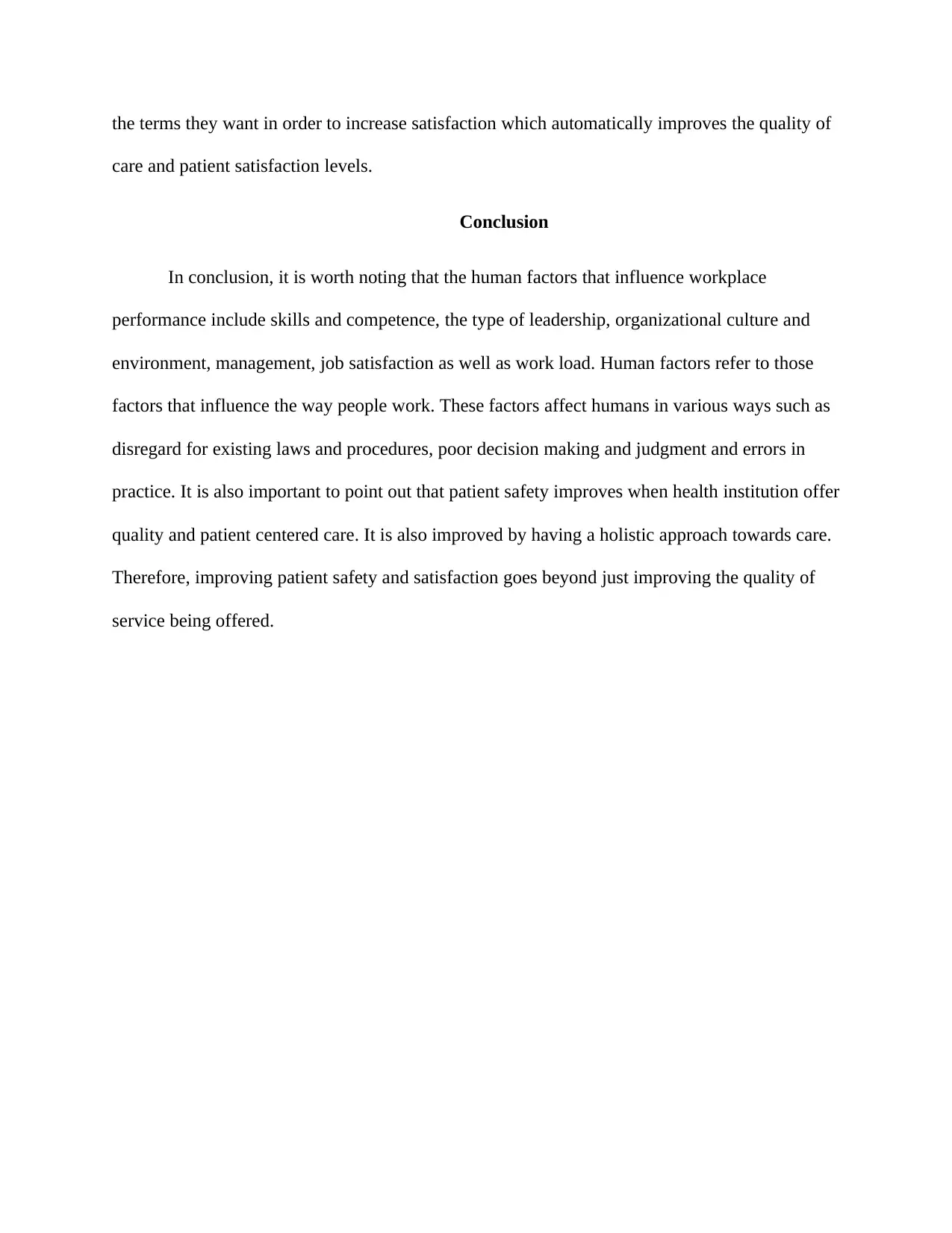
the terms they want in order to increase satisfaction which automatically improves the quality of
care and patient satisfaction levels.
Conclusion
In conclusion, it is worth noting that the human factors that influence workplace
performance include skills and competence, the type of leadership, organizational culture and
environment, management, job satisfaction as well as work load. Human factors refer to those
factors that influence the way people work. These factors affect humans in various ways such as
disregard for existing laws and procedures, poor decision making and judgment and errors in
practice. It is also important to point out that patient safety improves when health institution offer
quality and patient centered care. It is also improved by having a holistic approach towards care.
Therefore, improving patient safety and satisfaction goes beyond just improving the quality of
service being offered.
care and patient satisfaction levels.
Conclusion
In conclusion, it is worth noting that the human factors that influence workplace
performance include skills and competence, the type of leadership, organizational culture and
environment, management, job satisfaction as well as work load. Human factors refer to those
factors that influence the way people work. These factors affect humans in various ways such as
disregard for existing laws and procedures, poor decision making and judgment and errors in
practice. It is also important to point out that patient safety improves when health institution offer
quality and patient centered care. It is also improved by having a holistic approach towards care.
Therefore, improving patient safety and satisfaction goes beyond just improving the quality of
service being offered.
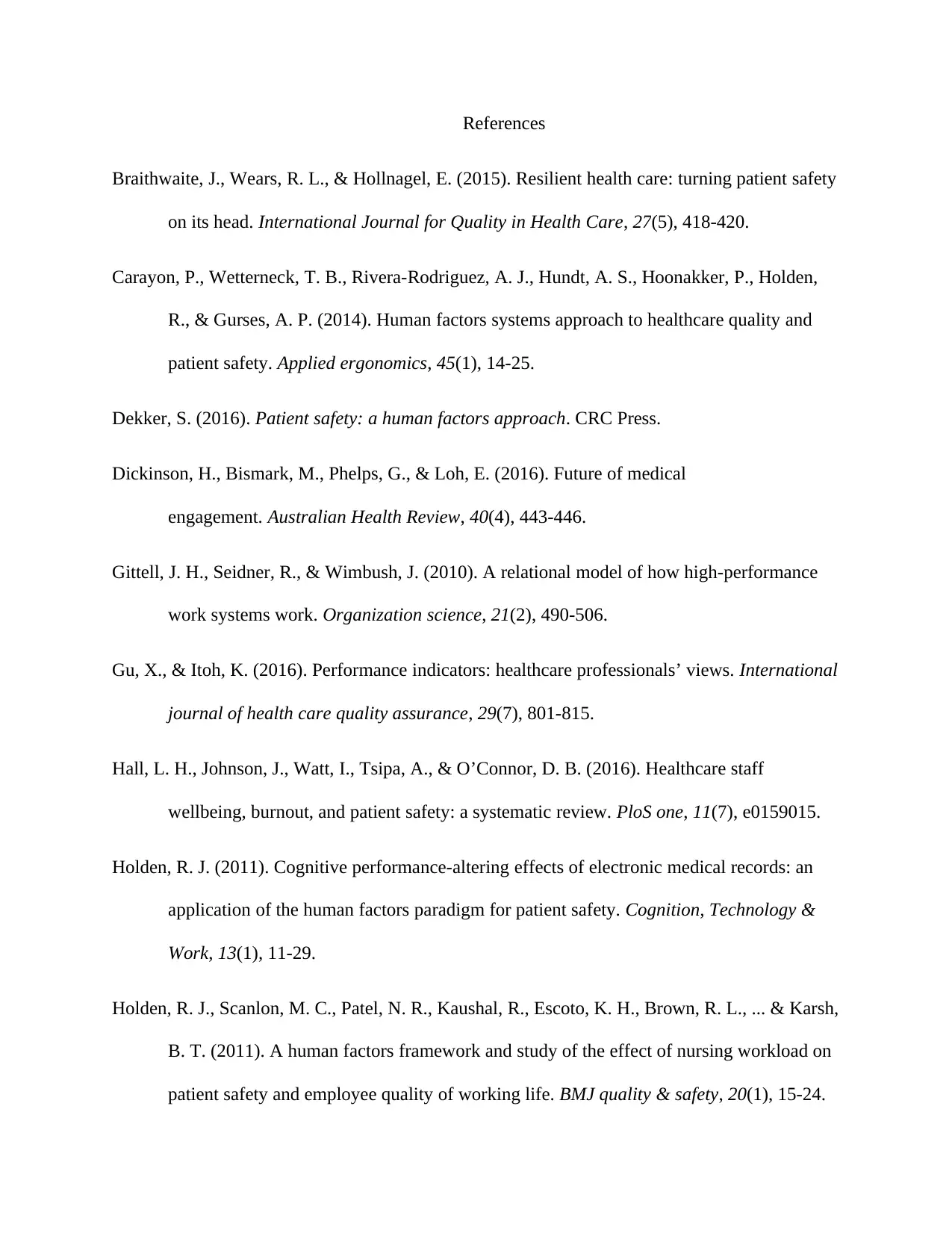
References
Braithwaite, J., Wears, R. L., & Hollnagel, E. (2015). Resilient health care: turning patient safety
on its head. International Journal for Quality in Health Care, 27(5), 418-420.
Carayon, P., Wetterneck, T. B., Rivera-Rodriguez, A. J., Hundt, A. S., Hoonakker, P., Holden,
R., & Gurses, A. P. (2014). Human factors systems approach to healthcare quality and
patient safety. Applied ergonomics, 45(1), 14-25.
Dekker, S. (2016). Patient safety: a human factors approach. CRC Press.
Dickinson, H., Bismark, M., Phelps, G., & Loh, E. (2016). Future of medical
engagement. Australian Health Review, 40(4), 443-446.
Gittell, J. H., Seidner, R., & Wimbush, J. (2010). A relational model of how high-performance
work systems work. Organization science, 21(2), 490-506.
Gu, X., & Itoh, K. (2016). Performance indicators: healthcare professionals’ views. International
journal of health care quality assurance, 29(7), 801-815.
Hall, L. H., Johnson, J., Watt, I., Tsipa, A., & O’Connor, D. B. (2016). Healthcare staff
wellbeing, burnout, and patient safety: a systematic review. PloS one, 11(7), e0159015.
Holden, R. J. (2011). Cognitive performance-altering effects of electronic medical records: an
application of the human factors paradigm for patient safety. Cognition, Technology &
Work, 13(1), 11-29.
Holden, R. J., Scanlon, M. C., Patel, N. R., Kaushal, R., Escoto, K. H., Brown, R. L., ... & Karsh,
B. T. (2011). A human factors framework and study of the effect of nursing workload on
patient safety and employee quality of working life. BMJ quality & safety, 20(1), 15-24.
Braithwaite, J., Wears, R. L., & Hollnagel, E. (2015). Resilient health care: turning patient safety
on its head. International Journal for Quality in Health Care, 27(5), 418-420.
Carayon, P., Wetterneck, T. B., Rivera-Rodriguez, A. J., Hundt, A. S., Hoonakker, P., Holden,
R., & Gurses, A. P. (2014). Human factors systems approach to healthcare quality and
patient safety. Applied ergonomics, 45(1), 14-25.
Dekker, S. (2016). Patient safety: a human factors approach. CRC Press.
Dickinson, H., Bismark, M., Phelps, G., & Loh, E. (2016). Future of medical
engagement. Australian Health Review, 40(4), 443-446.
Gittell, J. H., Seidner, R., & Wimbush, J. (2010). A relational model of how high-performance
work systems work. Organization science, 21(2), 490-506.
Gu, X., & Itoh, K. (2016). Performance indicators: healthcare professionals’ views. International
journal of health care quality assurance, 29(7), 801-815.
Hall, L. H., Johnson, J., Watt, I., Tsipa, A., & O’Connor, D. B. (2016). Healthcare staff
wellbeing, burnout, and patient safety: a systematic review. PloS one, 11(7), e0159015.
Holden, R. J. (2011). Cognitive performance-altering effects of electronic medical records: an
application of the human factors paradigm for patient safety. Cognition, Technology &
Work, 13(1), 11-29.
Holden, R. J., Scanlon, M. C., Patel, N. R., Kaushal, R., Escoto, K. H., Brown, R. L., ... & Karsh,
B. T. (2011). A human factors framework and study of the effect of nursing workload on
patient safety and employee quality of working life. BMJ quality & safety, 20(1), 15-24.
⊘ This is a preview!⊘
Do you want full access?
Subscribe today to unlock all pages.

Trusted by 1+ million students worldwide
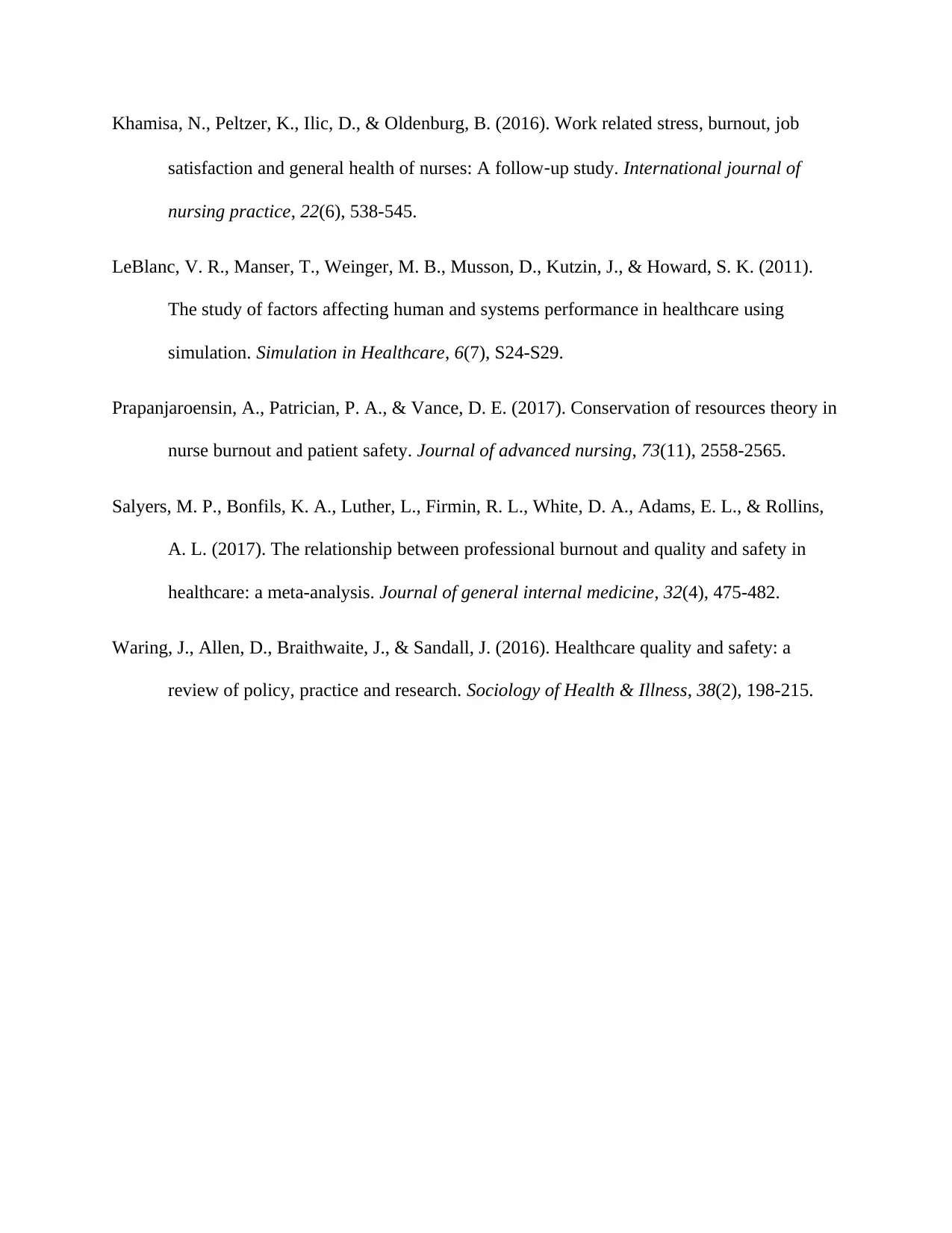
Khamisa, N., Peltzer, K., Ilic, D., & Oldenburg, B. (2016). Work related stress, burnout, job
satisfaction and general health of nurses: A follow‐up study. International journal of
nursing practice, 22(6), 538-545.
LeBlanc, V. R., Manser, T., Weinger, M. B., Musson, D., Kutzin, J., & Howard, S. K. (2011).
The study of factors affecting human and systems performance in healthcare using
simulation. Simulation in Healthcare, 6(7), S24-S29.
Prapanjaroensin, A., Patrician, P. A., & Vance, D. E. (2017). Conservation of resources theory in
nurse burnout and patient safety. Journal of advanced nursing, 73(11), 2558-2565.
Salyers, M. P., Bonfils, K. A., Luther, L., Firmin, R. L., White, D. A., Adams, E. L., & Rollins,
A. L. (2017). The relationship between professional burnout and quality and safety in
healthcare: a meta-analysis. Journal of general internal medicine, 32(4), 475-482.
Waring, J., Allen, D., Braithwaite, J., & Sandall, J. (2016). Healthcare quality and safety: a
review of policy, practice and research. Sociology of Health & Illness, 38(2), 198-215.
satisfaction and general health of nurses: A follow‐up study. International journal of
nursing practice, 22(6), 538-545.
LeBlanc, V. R., Manser, T., Weinger, M. B., Musson, D., Kutzin, J., & Howard, S. K. (2011).
The study of factors affecting human and systems performance in healthcare using
simulation. Simulation in Healthcare, 6(7), S24-S29.
Prapanjaroensin, A., Patrician, P. A., & Vance, D. E. (2017). Conservation of resources theory in
nurse burnout and patient safety. Journal of advanced nursing, 73(11), 2558-2565.
Salyers, M. P., Bonfils, K. A., Luther, L., Firmin, R. L., White, D. A., Adams, E. L., & Rollins,
A. L. (2017). The relationship between professional burnout and quality and safety in
healthcare: a meta-analysis. Journal of general internal medicine, 32(4), 475-482.
Waring, J., Allen, D., Braithwaite, J., & Sandall, J. (2016). Healthcare quality and safety: a
review of policy, practice and research. Sociology of Health & Illness, 38(2), 198-215.
1 out of 10
Related Documents
Your All-in-One AI-Powered Toolkit for Academic Success.
+13062052269
info@desklib.com
Available 24*7 on WhatsApp / Email
![[object Object]](/_next/static/media/star-bottom.7253800d.svg)
Unlock your academic potential
Copyright © 2020–2025 A2Z Services. All Rights Reserved. Developed and managed by ZUCOL.




